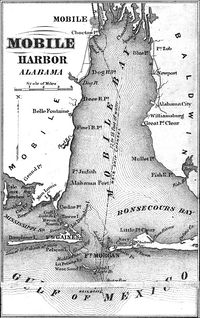Fort Gaines (1)
|
Fort Gaines (1821-1946) - Construction on this Third System masonry fort began in 1821 but construction and funding problems prevented completion and a redesigned fort was started in the 1850's. Designed by Joseph G. Totten and named after Gen. Edmund P. Gaines in 1853. The fort was still incomplete in 1861 when the U.S. Civil War began. The fort was occupied by Confederate forces in 1861 and they finished the fort in 1862. Abandoned after World War I and reactivated during World War II it was abandoned after the end of World War II.
History Part of the Harbor Defense of Mobile, Alabama. Established to defend the narrow entrance to Mobile Bay, Alabama along with Fort Morgan (1).
Fort Gaines was designed as a regular pentagon with bastions at each corner and ten guns mounted on each of the five walls. Each bastion was to have four flank howitzers. A thirty-five-foot wide dry moat surrounded the twenty-two foot high walls with a drawbridge for access.
U.S. Civil War (1861-1865)  At the beginning of the U.S. Civil War in 1861, the Alabama State Militia seized both Fort Gaines and Fort Morgan (1) from Federal troops. Fort Gaines remained in Confederate hands until 8 Aug 1864 when it was surrendered after the Battle of Mobile Bay to a Union fleet commanded by Adm. David Farragut. The Battle of Mobile Bay was the occasion for Adm. Farragut's famous order, "Damn the torpedoes, full speed ahead!", referring to torpedoes (mines) strung across the channel into Mobile Bay.
Endicott Period (1890-1910)In March of 1898 the fort was reactivated and garrisoned in anticipation of the Spanish American War and as a result of the explosion that sunk the Battleship Maine in Havana Harbor 15 Feb 1898. Construction began on the first Endicott Period battery in 1898. Three Endicott Period batteries were built between 1898 and 1901. The Spanish American War was quickly over but the strengthening of coastal defenses continued.
World War I (1917-1918)A Coastal Artillery unit manned the disappearing guns during World War I. An anti-aircraft gunnery school operated from Fort Gains during and following the war. World War II (1941-1945)The fort was used by the Alabama National Guard and the U.S. Coast Guard during World War II. Current StatusThe United States sold Fort Gaines to the City of Mobile in 1926. The city in turn gave the property to the Alabama Department of Conservation, which deeded it to the Dauphin Island Park and Beach Board.
See Also:
Sources:
Links: Visited: 23 Dec 2011, 10 Dec 2009 Picture Gallery
| |||||||||||||||||||||||||||||||||||||||||
- Harbor Defense of Mobile
- Visited
- All
- Alabama All
- Alabama Forts
- Alabama Mobile County
- Third System Forts
- Endicott Period Forts
- World War I Forts
- World War I Coastal Forts
- World War II Forts
- World War II Coastal Forts
- Coastal Forts
- U.S. Civil War Forts
- Fort Gaines (1)
- Starter Page
- 2009 Southern Trip
- 2011-2012 Trip
- CDSG Conference 2013
- Civil War Defenses of Mobile









